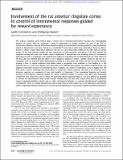Files in this item
Involvement of the rat anterior cingulate cortex in control of instrumental responses guided by reward expectancy
Item metadata
| dc.contributor.author | Schweimer, Judith | |
| dc.contributor.author | Hauber, Wolfgang | |
| dc.date.accessioned | 2021-07-16T09:30:12Z | |
| dc.date.available | 2021-07-16T09:30:12Z | |
| dc.date.issued | 2005-05 | |
| dc.identifier | 275054747 | |
| dc.identifier | 813cfa40-892b-44ca-b7ec-c09e78728ec1 | |
| dc.identifier | 21844475869 | |
| dc.identifier | 15930509 | |
| dc.identifier.citation | Schweimer , J & Hauber , W 2005 , ' Involvement of the rat anterior cingulate cortex in control of instrumental responses guided by reward expectancy ' , Learning and Memory , vol. 12 , no. 3 , pp. 334-342 . https://doi.org/10.1101/lm.90605 | en |
| dc.identifier.issn | 1072-0502 | |
| dc.identifier.other | ORCID: /0000-0002-5968-3534/work/108119024 | |
| dc.identifier.uri | https://hdl.handle.net/10023/23588 | |
| dc.description.abstract | The anterior cingulate cortex (ACC) plays a critical role in stimulus-reinforcement learning and reward-guided selection of actions. Here we conducted a series of experiments to further elucidate the role of the ACC in instrumental behavior involving effort-based decision-making and instrumental learning guided by reward-predictive stimuli. In Experiment 1, rats were trained on a cost-benefit T-maze task in which they could either choose to climb a barrier to obtain a high reward (four pellets) in one arm or a low reward (two pellets) in the other with no barrier present. In line with previous studies, our data reveal that rats with quinolinic acid lesions of the ACC selected the response involving less work and smaller reward. Experiment 2 demonstrates that breaking points of instrumental performance under a progressive ratio schedule were similar in sham-lesioned and ACC-lesioned rats. Thus, lesions of the ACC did not interfere with the effort a rat is willing to expend to obtain a specific reward in this test. In a subsequent task, we examined effort-based decision-making in a lever-press task where rats had the choice between pressing a lever to receive preferred food pellets under a progressive ratio schedule, or free feeding on a less preferred food, i.e. lab chow. Results show that sham- and ACC-lesioned animals had similar breaking points and ingested comparable amounts of less-preferred food. Together, the results of Experiment 1 and 2 suggest that the ACC plays a role in evaluating how much effort to expend for reward; however, the ACC is not necessary in all situations requiring an assessment of costs and benefits. In Experiment 3 we investigated learning and reversal learning of instrumental responses guided by reward predictive stimuli. A reaction time (RT) task demanding conditioned lever release was used in which the upcoming reward magnitude (five vs. one food pellet) was signalled in advance by discriminative visual stimuli. Results revealed that rats with ACC lesions were able to discriminate reward magnitude-predictive stimuli and to adapt instrumental behavior to reversed stimulus-reward magnitude contingencies. Thus, in a simple discrimination task as used here, the ACC appears not to be required to discriminate reward magnitude-predictive stimuli and to use the learned significance of the stimuli to guide instrumental behavior. | |
| dc.format.extent | 9 | |
| dc.format.extent | 472320 | |
| dc.language.iso | eng | |
| dc.relation.ispartof | Learning and Memory | en |
| dc.subject | RC0321 Neuroscience. Biological psychiatry. Neuropsychiatry | en |
| dc.subject | Neuropsychology and Physiological Psychology | en |
| dc.subject | Cognitive Neuroscience | en |
| dc.subject | Cellular and Molecular Neuroscience | en |
| dc.subject.lcc | RC0321 | en |
| dc.title | Involvement of the rat anterior cingulate cortex in control of instrumental responses guided by reward expectancy | en |
| dc.type | Journal article | en |
| dc.contributor.institution | University of St Andrews. School of Psychology and Neuroscience | en |
| dc.identifier.doi | https://doi.org/10.1101/lm.90605 | |
| dc.description.status | Peer reviewed | en |
This item appears in the following Collection(s)
Items in the St Andrews Research Repository are protected by copyright, with all rights reserved, unless otherwise indicated.

